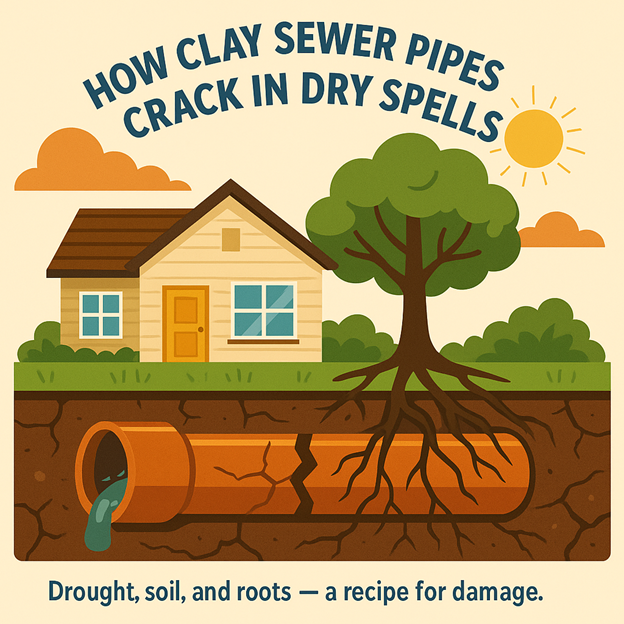In Fort Wayne and across much of the Midwest, many homes still rely on aging clay sewer pipes buried deep beneath their yards. These pipes, common in homes built before the 1980s, were once considered the gold standard for durability. But in today’s changing climate, particularly during hot and dry Indiana summers, they can quickly become a hidden source of costly damage. This article explores how dry spells wreak havoc on these fragile pipes and what local homeowners can do to prevent disaster.
1. Understanding Clay Sewer Pipes
- Clay pipes, typically made from vitrified clay, were widely used due to their natural resistance to chemical corrosion and long lifespan
- They are brittle by nature and laid in segments with jointed connections rather than seamless construction
- Clay joints often relied on mortared collars or felt-wrapped connections, which degrade over time
- Roots, frost heave, and foundation settling introduce stress points at weak joints
Why this matters: Even minor cracks can allow roots, soil, or water to infiltrate the pipe, leading to blockages, backups, or full collapses under your yard — often without immediate signs until major damage has occurred.
2. What Happens During a Dry Spell?
- Prolonged dry conditions cause clay-heavy Indiana soil to shrink and crack
- This soil movement pulls away from buried pipes, removing their natural bedding and support
- Unsupported sections may sag, collapse under their own weight, or shear against stable joints
- Clay pipes, being rigid and unforgiving, are particularly prone to hairline fractures during these shifts
Common effects of soil contraction:
- Cracking at pipe joints from uneven lateral pressure
- Shearing damage from uneven settlement, especially near foundation entry points
- Formation of pipe “bellies” (low spots) that trap solids and restrict flow
- Creation of air pockets or voids beneath pipe bedding that further accelerate collapse
Climate connection: Midwest dry spells are often followed by sudden rainstorms. The reintroduction of water into loosened soil creates surges that destabilize already vulnerable clay segments — sometimes causing an entire pipe section to shift overnight.
3. Signs Your Clay Sewer Pipe is in Trouble
- Gurgling sounds from toilets or slow drains, especially during or after a dry spell
- Foul odors in the yard or basement, indicating gas escaping through cracked joints
- Unexplained patches of green, spongy grass above buried pipe runs
- Shifting soil near the foundation or visible cracking in patios and walkways
- Recurring sewage backups or overflow at cleanouts, especially during water usage spikes
- Increased ant or rodent activity near utility entrances, drawn by escaping gases or moisture
4. How to Prevent Dry Weather Pipe Damage
Stay proactive with these steps:
- Schedule a sewer camera inspection with a Fort Wayne expert like AAA Sewer Service at the start and end of each summer
- Add moisture retention landscaping around the home — mulch, native grasses, and shade trees can slow soil drying
- Water foundation beds moderately during extreme heatwaves to maintain consistent soil density
- Avoid excessive foundation irrigation, which can cause rapid expansion and compound the issue
- Install root barriers if trees are within 10–15 feet of the lateral line
Bonus prevention tip: Use “smart irrigation systems” that regulate yard watering based on real-time weather data to minimize soil volatility without overwatering
5. Long-Term Solutions: Repair or Replace?
Reline if:
- The clay pipe is mostly intact with some surface cracks, root intrusion, or moderate offsetting
- You want to avoid excavation and preserve landscaping
- Pipe diameter is still viable and not extensively eroded from inside
Replace if:
- Multiple segments are crushed, misaligned, or have deep fractures
- The pipe has settled unevenly, creating long-term drainage issues
- Your property is undergoing major renovations or you’re planning to sell soon — replacement adds long-term value
- You’re switching to high-efficiency fixtures and need a smoother system to handle increased pressure and velocity
Modern materials available:
- HDPE (High-Density Polyethylene) for flexibility and chemical resistance
- PVC SDR-35 for affordability and smooth interior walls
- CIPP (Cured-in-Place Pipe) liners for trenchless rehabilitation
Fort Wayne Soil and Clay Pipes: A Risky Mix
With Indiana’s notorious freeze-thaw cycles, tree-lined neighborhoods, and drought-prone summers, homes in areas like Lakeside Park, West Central, and Foster Park are especially vulnerable. Many properties in these areas were built in the 1930s–1960s — a peak era for clay lateral installation. The convergence of dry spells, aging infrastructure, and root-heavy landscaping creates a perfect storm for underground sewer failure.
Did you know? Fort Wayne’s clay subsoils contract more aggressively than sandy or loamy soils. That means damage can happen silently — even when there’s no rain, no storm, and no warning.
Final Tip: Don’t Wait for a Backup to Find the Crack
A cracked clay pipe won’t fix itself. Once dry soil causes a pipe to shift, settle, or fracture, it becomes a gateway for roots, insects, and gas. Worse, it can collapse during a storm — just when your system is under the most strain.
Fortunately, AAA Sewer Service provides Fort Wayne homeowners with:
- Non-invasive sewer camera inspections
- Hydro jetting to clear debris and roots
- Trenchless pipe lining to reinforce clay pipes
- Full lateral replacement options when needed
Don’t let a dry summer become an expensive fall.
📞 Call AAA Sewer Service at (260) 456-6930
🌐 Visit our website: www.aaasewerservice.com

